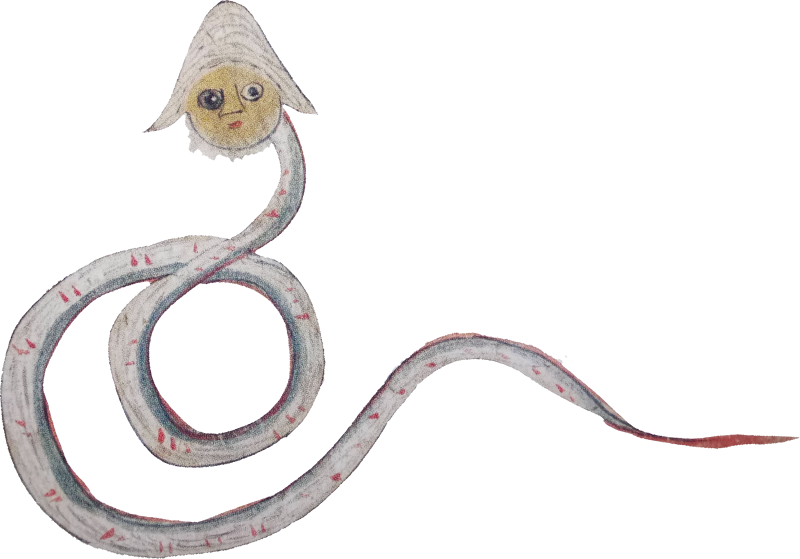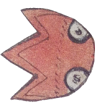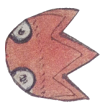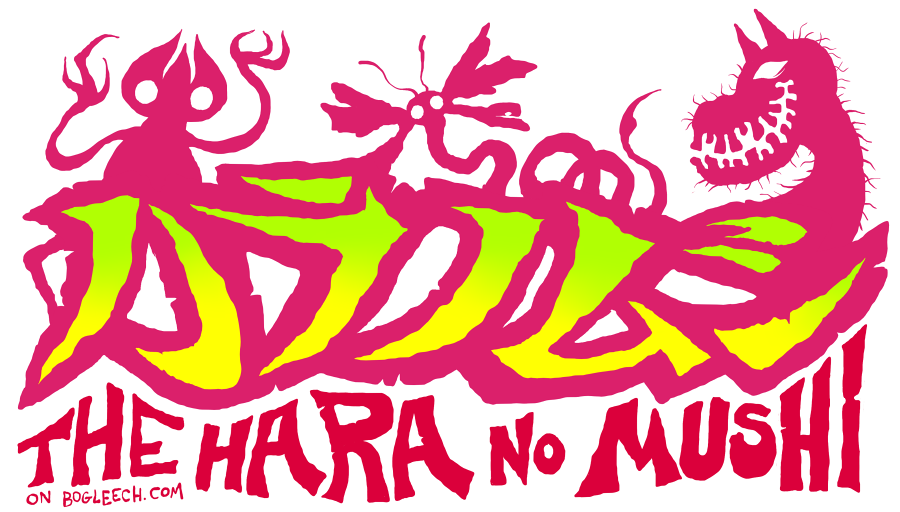
DAY THIRTY ONE: KOSHOUI
("Pageboy")
Written by Jonathan Wojcik, Researched and Translated by Rev Storm
According to "The Zuo Tradition" ((ancient Chinese historical text)), it originates with an incident in 580 BC. In May of that year Duke Jing of the Jin Dynasty fell ill, and by June his condition was dire. Duke Huan, of the Zhou Dynasty state of Qin, sent the legendary physician Huan (written with a different character) to see him. While he waited for the physician to arrive, Duke Jing had a dream in which the sickness appeared before him in the form of two children. One child said "That physician will surely do away with us," but the other responded "As long as we hide above the fat and below the blind eye, he can do nothing."
A word written "fat-blind" means "incurable illness, " and the Chinese word for "child" also means "pageboy." In other words, the Duke's dream was about a pageboy delivering the news that his sickness was incurable. ((This is another instance of puns having great power in Chinese tradition.))
[Its habitat is] "Above the fat and below the blind eye" (where no acupuncture needle or medicine can reach).
It has eyes, nose, and a mouth on its flesh-colored, childlike face, on which it grows a white beard. Its body is like that of a white snake, and its tail is yellow. It prattles on like a child, and loves sweet sake. ((There weren't age limitations on drinking at the time.))
Those possessed by this bug are seized by an incurable illness. It could not be cured by even the legendary physician. No medical treatment proved effective, since its hat repelled medicine, and it hid in a place no needle could reach."
Design Review:
This is our last "bug" for reasons I think are obvious. For one, it is one of the only bugs in the book to be deemed INCURABLE. For another, we have that incredibly haunting story in which a disease manifests in a dream as a pair of wicked little children. Finally we have the very form this creature takes, with a bearded baby face that apparently even babbles like a toddler. Everything about Koshou is astoundingly ghostly and unsettling, and it's even another of those bugs with a medicine-resistant "hat" for good measure.I feel that this one stands so well on its own, I almost wasn't going to include a real-world parasite at all, but there is a fairly suitable kind of "infection" here, and since it's also our last one, we're going to build up to it with...
NINE BONUS PARASITES!
So many, many things can infect and infest the human body, we could never have been able to fit them all in a single monthly review series, but just for you, we're going to squeeze in an entire extra nine before we get to a tenth and final tiny terror! Happy Halloween!!!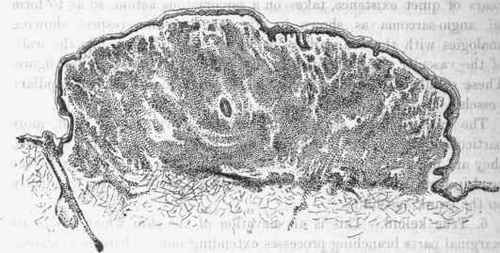
PAPILLOMAVIRUS
We discussed already how viruses "might" qualify as parasites, and perhaps some of the weirdest are the viruses capable of causing warts. There are in fact at least 130 types of viruses responsible for various types of wart, an excess of tough skin cells that the virus essentially uses as a sort of "colony" or "hive" for itself. Papillomaviruses are usually spread by skin-to-skin contact, but can also survive for short periods of time in moist enough conditions, with one of the most common vectors being the wet floors of public showers.
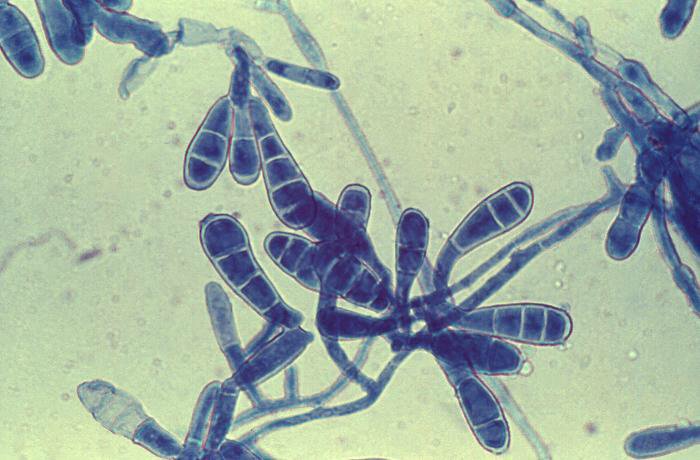
RINGWORM
Despite the name, "ringworm" is actually a parasitic fungal infection of the human skin, and can be caused by about forty species of fungus, which actually feed on the skin's keratin content. As a fungus, most of the organism consists of a network of thread-like mycelia, and the signature "ring" is interestingly enough the result of the inner mycelia dying off as the fungus spreads outwards - the same reason why mushrooms form what some call "fairy rings."
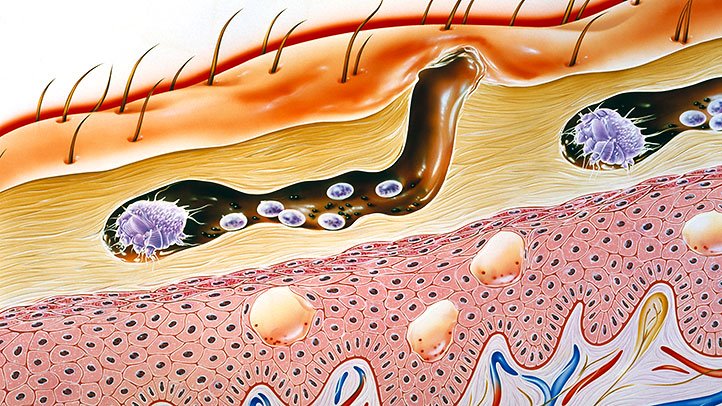
SCABIES
We've covered a couple of insects in this feature, but this is our first arachnid! Scabies is caused by a species of microscopic mite, Sarcoptes scabiei, and just look at this lovely illustration! The mites quite literally tunnel through your upper layers of skin as they feed, and they fill that tunnel behind them with their waste products, by the way, as well as their eggs. Needless to say, it's not a pleasant experience for the host.
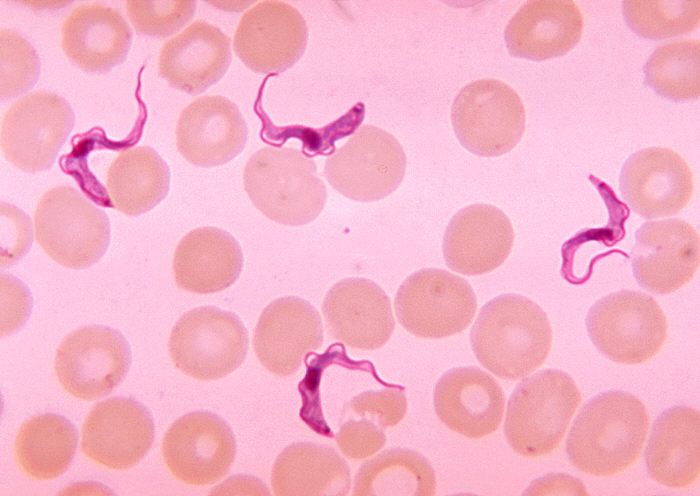
SLEEPING SICKNESS
This is a protozoan parasite, Trypanosoma brucei, which is famously transmitted by the bite of the bloodsucking Tsetse fly. In the bloodstream, the flagellates multiply rapidly and even adapt quickly to the host's antibodies, changing their outer coating so that they're no longer recognized by our established immune response. The parasites also happen to excrete a compound known as tryptophol, the same thing in wine that can cause people to fall asleep, and causes hosts to fall asleep unexpectedly and for long periods of time.
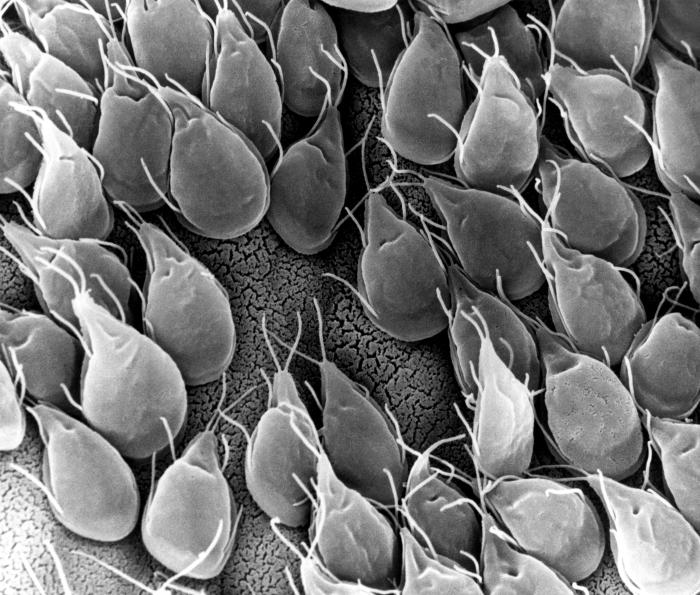
GIARDIA
We mentioned this one briefly just yesterday, but Giardia is also referred to as the adorable "Beaver Fever," though there's nothing quite as cute about diarrhea so bad it can dehydrate you to death. Just look at these little fellas, though! Most images of the Giardia protozoan focus on the fact that it has, remarkably enough, two equally sized nuclei resembling a pair of big ol' eyes staring back at you, which is lovable, don't get me wrong, but it takes a Scanning Electron Microscope image like this to appreciate their flattened teadrop-like shape, the underside of which is one big, broad sucker for clinging to the lining of your digestive tract. DON'T DRINK OUT OF RIVERS.
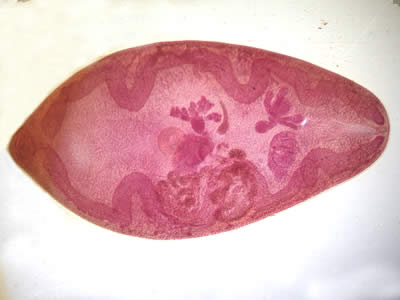
LUNG FLUKE
One more fluke that naturally attacks humans, and it's another big one, too! About the size of a "coffee bean" according to some writing, you can get this fluke from eating raw, freshwater shrimp or crawfish, and it also surrounds itself with a hardened outer shell or bean pod sort of growth as it sits nestled in your lung tissue, producing eggs that you're intended to cough up in phlegm, swallow, and defecate, hopefully into a nice pond or stream where another mud bug can get them. This one might have actually been appropriate for "death bug" the other day, because its symptoms can resemble tuberculosis, though it isn't nearly as deadly.
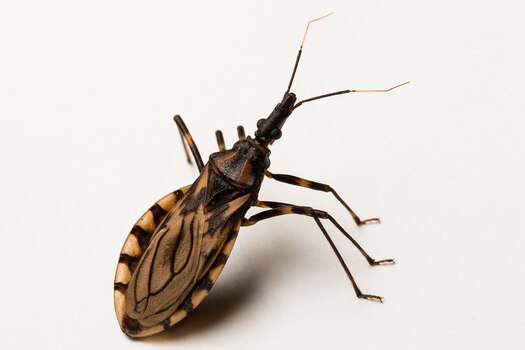
CHAGA'S DISEASE
This is another single celled trypanosome, like sleeping sickness, and it can actually lead to total heart failure up to a decade after infection. That's pretty nasty! What we're showing you here is the biting insect that transmits this parasite, the "bloodsucking cone-nose" or "kissing bug." News of its spread in North America has recently become a hot topic, and unfortunately, one surrounded by many misconceptions. Some are even trying to connect it with illegal immigration (of course), despite the fact that the bug is already found in North America anyway. None of our cone-nose populations appear to carry the disease, and in fact, every case of Chagas ever reported in the United States was brought back home by an American tourist. People who live under the constant threat of the infection tend to be better prepared to avoid it.
On another note, the "kissing bugs" are part of the assassin bug family, and the many other species of assassin bug have been consequently causing false panic around the internet. Feeding on mammalian blood is not normal for the group at all, which evolved first to prey upon their fellow insects and other small organisms. Get to know what the kissing bugs really look like before you go smushing any poor, innocent wheel bugs or bee assassins!
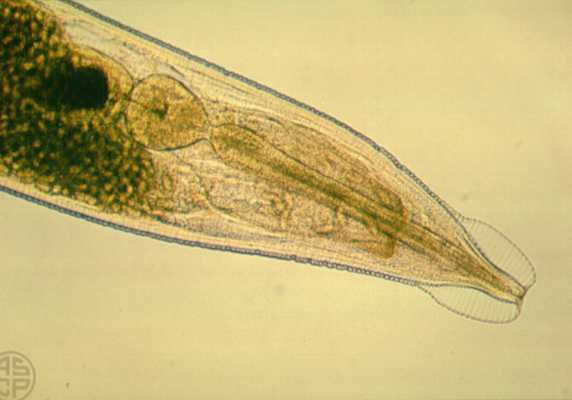
PINWORM
I'm not sure you recall, but our very first mushi, Gyoshuu, was actually just the Japanese word for this parasite, despite having little else in common with it. Pinworm, or threadworm, is practically the "common cold" of parasitic worms; not very dangerous and easy to get rid of, but obnoxiously common and incredibly easy to pick up if you're not careful. These worms infest the human colon, and at night, when she detects her host is resting, the adult female will stick her head right out of the anus to lay her eggs. This causes the area to itch terribly, which is in fact a manipulative tactic to further their spread: it makes the host scratch and dig around in there, then spread the sticky eggs around on their filthy disgusting fingers.
This is why the vast majority of pinworm infections afflict small children and people who have to interact with them on the regular. NASTY! When us childless old people get them, it's more often because someone's baby smeared the eggs on a doorknob or the handle of a shopping cart.

MALARIA
Our last protozoan, and the third in this very list to be carried by a blood-drinking insect. Malaria is one of the deadliest diseases in the world, and is why the mosquito is often considered the deadliest animal, though that hardly seems fair, does it? The parasite is using the mosquito, just as much as it's using us to complete its life cycle as well. Interestingly, this protozoan multiplies parasitically within our own red blood cells in a much more virus-like manner, causing them to burst with tiny new offspring perfectly adapted to survive within a hungry, female mosquito.
And our very last parasite, or rather "parasite" is....
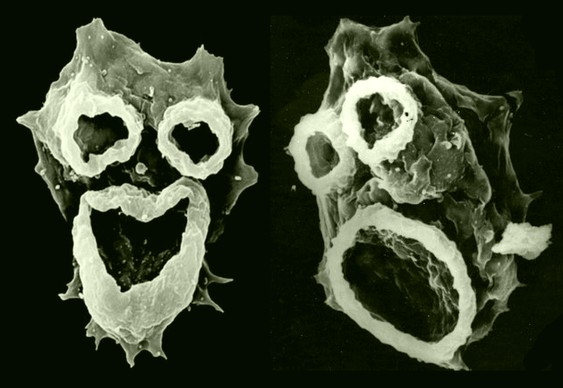
NAEGLERIA FOWLERI
We're cheating here, because the infamous "brain-eating amoeba" isn't normally a parasite at all, but a hunter-killer of bacteria, penetrating through their cell walls and ravenously sucking out their contents. Extremely sensitive to even moderate cold, it's usually content to feast on the bacteria found in hot springs or water we humans might at least find comfortably warm on a summer day, including where industrial activity is warming water artificially.
"Infection" occurs only when this protozoan is accidentally inhaled into the sinuses of a vertebrate, where it easily finds its way into the brain...and what it finds there is a vast, seemingly endless buffet of strange, simplistic cells even more appetizing and even more helpless than its usual bacterial prey. Multiplying exponentially as they feast on our neurons, the amoebae can cause confusion, seizures and hallucinations within about a week, and death by the third or fourth week of infection. The fatality rate is in fact more than 95% with even the best treatments we know, and the number of people to have survived fowleri is in the single digits. The only upside is that infection is still incredibly rare, with only dozens of cases known world-wide, but you should still be wary of any unfiltered, natural water sources that aren't at least a little nippy.
The extreme deadliness of this amoeba, the hallucinations and its location behind your eyes feel like a remarkably good match for today's final mushi, though once again, we should remember that this wasn't necessarily the point of the creatures at all. Even where they obviously crossed over or drew inspiration from real maladies, they probably weren't intended to represent them too literally, but served as a symbolic visual aid for anyone studying health at the time.
If you're interested in picking up the same book we did, you can find more than one version on ebay or amazon under "harikikigaki" or "hara no mushi," though no version comes fully translated. If you would like to read Rev Storm's actual translation document for the 31 bugs we've now covered, you can download that HERE!
We're also going to do one final, extra page of this feature in another few weeks...showcasing reader-submitted artwork of the hara no mushi! All work-safe original submissions will be added to the gallery! You can draw existing mushi, reinterpret them entirely, or make up your own! Anything goes!
